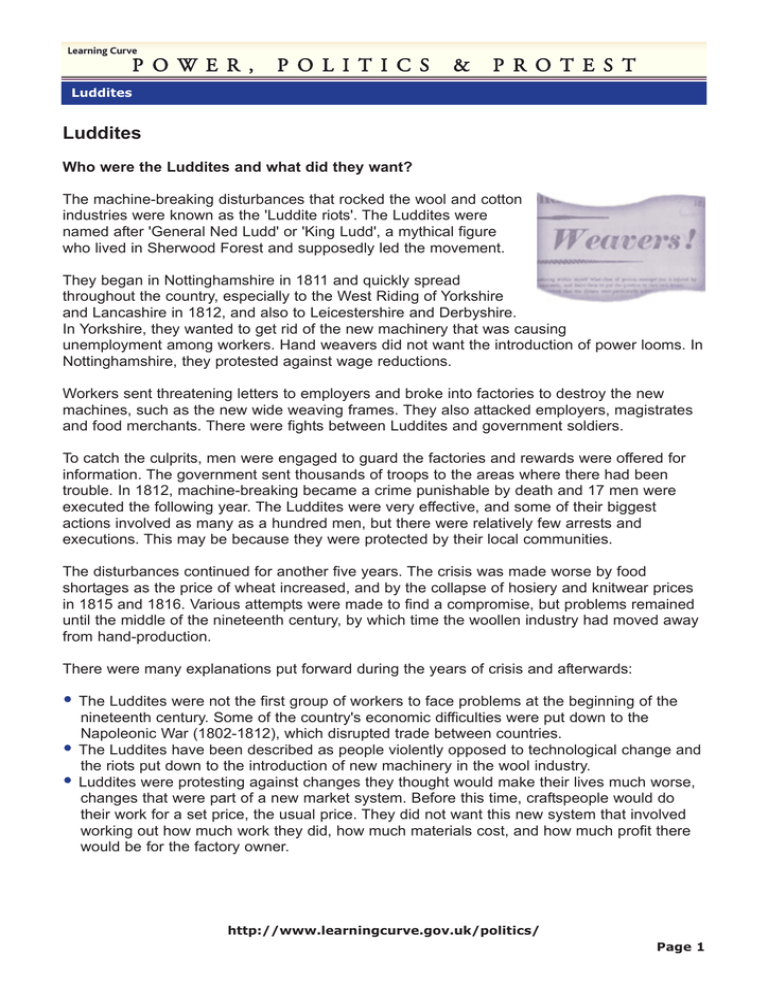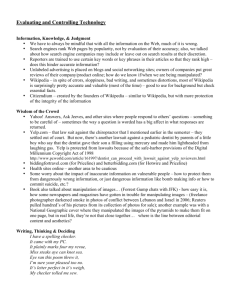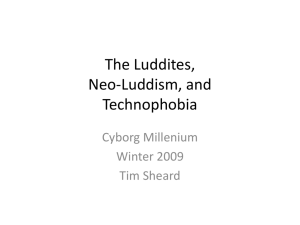m l t b o I == m l i... Luddites
advertisement

Learning Curve m l t b o I = m l i f q f ` p = C = m o l q b p q Luddites Luddites Who were the Luddites and what did they want? The machine-breaking disturbances that rocked the wool and cotton industries were known as the 'Luddite riots'. The Luddites were named after 'General Ned Ludd' or 'King Ludd', a mythical figure who lived in Sherwood Forest and supposedly led the movement. They began in Nottinghamshire in 1811 and quickly spread throughout the country, especially to the West Riding of Yorkshire and Lancashire in 1812, and also to Leicestershire and Derbyshire. In Yorkshire, they wanted to get rid of the new machinery that was causing unemployment among workers. Hand weavers did not want the introduction of power looms. In Nottinghamshire, they protested against wage reductions. Workers sent threatening letters to employers and broke into factories to destroy the new machines, such as the new wide weaving frames. They also attacked employers, magistrates and food merchants. There were fights between Luddites and government soldiers. To catch the culprits, men were engaged to guard the factories and rewards were offered for information. The government sent thousands of troops to the areas where there had been trouble. In 1812, machine-breaking became a crime punishable by death and 17 men were executed the following year. The Luddites were very effective, and some of their biggest actions involved as many as a hundred men, but there were relatively few arrests and executions. This may be because they were protected by their local communities. The disturbances continued for another five years. The crisis was made worse by food shortages as the price of wheat increased, and by the collapse of hosiery and knitwear prices in 1815 and 1816. Various attempts were made to find a compromise, but problems remained until the middle of the nineteenth century, by which time the woollen industry had moved away from hand-production. There were many explanations put forward during the years of crisis and afterwards: · · · The Luddites were not the first group of workers to face problems at the beginning of the nineteenth century. Some of the country's economic difficulties were put down to the Napoleonic War (1802-1812), which disrupted trade between countries. The Luddites have been described as people violently opposed to technological change and the riots put down to the introduction of new machinery in the wool industry. Luddites were protesting against changes they thought would make their lives much worse, changes that were part of a new market system. Before this time, craftspeople would do their work for a set price, the usual price. They did not want this new system that involved working out how much work they did, how much materials cost, and how much profit there would be for the factory owner. http://www.learningcurve.gov.uk/politics/ Page 1 Learning Curve m l t b o I = m l i f q f ` p = C = m o l q b p q Luddites Find out more from these original sources: Account of machinebreaking, 1812 Reward poster to catch men who wrecked machines Handbill entitled 'Fellow Weavers', 1812 Statement by the people of Royton, 1808 Letter on the situation in Nottingham, 1812 http://www.learningcurve.gov.uk/politics/ Page 2


